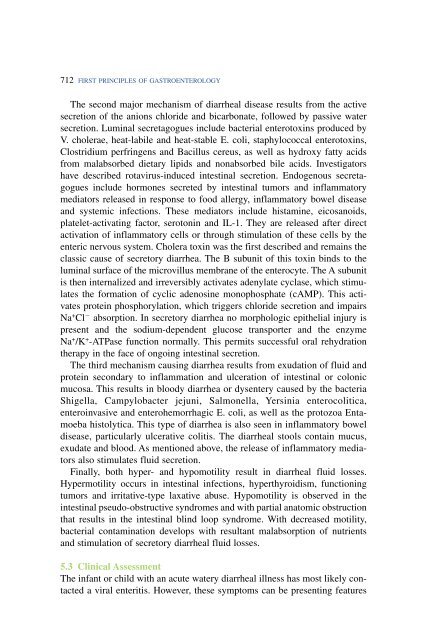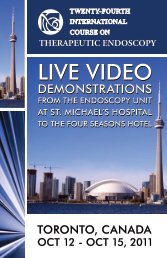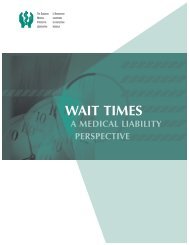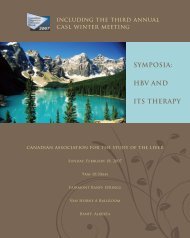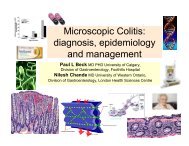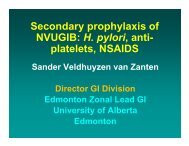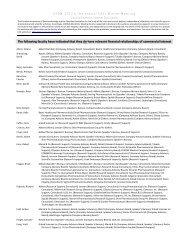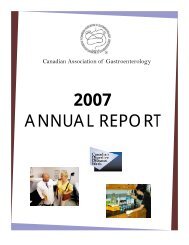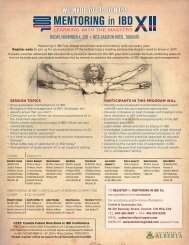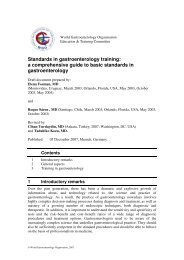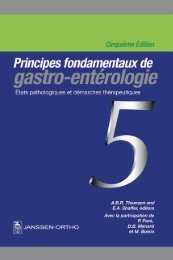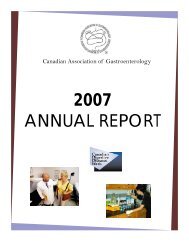Manifestations of Gastrointestinal Disease in the Child
Manifestations of Gastrointestinal Disease in the Child
Manifestations of Gastrointestinal Disease in the Child
You also want an ePaper? Increase the reach of your titles
YUMPU automatically turns print PDFs into web optimized ePapers that Google loves.
712 FIRST PRINCIPLES OF GASTROENTEROLOGY<br />
The second major mechanism <strong>of</strong> diarrheal disease results from <strong>the</strong> active<br />
secretion <strong>of</strong> <strong>the</strong> anions chloride and bicarbonate, followed by passive water<br />
secretion. Lum<strong>in</strong>al secretagogues <strong>in</strong>clude bacterial enterotox<strong>in</strong>s produced by<br />
V. cholerae, heat-labile and heat-stable E. coli, staphylococcal enterotox<strong>in</strong>s,<br />
Clostridium perfr<strong>in</strong>gens and Bacillus cereus, as well as hydroxy fatty acids<br />
from malabsorbed dietary lipids and nonabsorbed bile acids. Investigators<br />
have described rotavirus-<strong>in</strong>duced <strong>in</strong>test<strong>in</strong>al secretion. Endogenous secretagogues<br />
<strong>in</strong>clude hormones secreted by <strong>in</strong>test<strong>in</strong>al tumors and <strong>in</strong>flammatory<br />
mediators released <strong>in</strong> response to food allergy, <strong>in</strong>flammatory bowel disease<br />
and systemic <strong>in</strong>fections. These mediators <strong>in</strong>clude histam<strong>in</strong>e, eicosanoids,<br />
platelet-activat<strong>in</strong>g factor, seroton<strong>in</strong> and IL-1. They are released after direct<br />
activation <strong>of</strong> <strong>in</strong>flammatory cells or through stimulation <strong>of</strong> <strong>the</strong>se cells by <strong>the</strong><br />
enteric nervous system. Cholera tox<strong>in</strong> was <strong>the</strong> first described and rema<strong>in</strong>s <strong>the</strong><br />
classic cause <strong>of</strong> secretory diarrhea. The B subunit <strong>of</strong> this tox<strong>in</strong> b<strong>in</strong>ds to <strong>the</strong><br />
lum<strong>in</strong>al surface <strong>of</strong> <strong>the</strong> microvillus membrane <strong>of</strong> <strong>the</strong> enterocyte. The A subunit<br />
is <strong>the</strong>n <strong>in</strong>ternalized and irreversibly activates adenylate cyclase, which stimulates<br />
<strong>the</strong> formation <strong>of</strong> cyclic adenos<strong>in</strong>e monophosphate (cAMP). This activates<br />
prote<strong>in</strong> phosphorylation, which triggers chloride secretion and impairs<br />
Na + Cl absorption. In secretory diarrhea no morphologic epi<strong>the</strong>lial <strong>in</strong>jury is<br />
present and <strong>the</strong> sodium-dependent glucose transporter and <strong>the</strong> enzyme<br />
Na + /K + -ATPase function normally. This permits successful oral rehydration<br />
<strong>the</strong>rapy <strong>in</strong> <strong>the</strong> face <strong>of</strong> ongo<strong>in</strong>g <strong>in</strong>test<strong>in</strong>al secretion.<br />
The third mechanism caus<strong>in</strong>g diarrhea results from exudation <strong>of</strong> fluid and<br />
prote<strong>in</strong> secondary to <strong>in</strong>flammation and ulceration <strong>of</strong> <strong>in</strong>test<strong>in</strong>al or colonic<br />
mucosa. This results <strong>in</strong> bloody diarrhea or dysentery caused by <strong>the</strong> bacteria<br />
Shigella, Campylobacter jejuni, Salmonella, Yers<strong>in</strong>ia enterocolitica,<br />
entero<strong>in</strong>vasive and enterohemorrhagic E. coli, as well as <strong>the</strong> protozoa Entamoeba<br />
histolytica. This type <strong>of</strong> diarrhea is also seen <strong>in</strong> <strong>in</strong>flammatory bowel<br />
disease, particularly ulcerative colitis. The diarrheal stools conta<strong>in</strong> mucus,<br />
exudate and blood. As mentioned above, <strong>the</strong> release <strong>of</strong> <strong>in</strong>flammatory mediators<br />
also stimulates fluid secretion.<br />
F<strong>in</strong>ally, both hyper- and hypomotility result <strong>in</strong> diarrheal fluid losses.<br />
Hypermotility occurs <strong>in</strong> <strong>in</strong>test<strong>in</strong>al <strong>in</strong>fections, hyperthyroidism, function<strong>in</strong>g<br />
tumors and irritative-type laxative abuse. Hypomotility is observed <strong>in</strong> <strong>the</strong><br />
<strong>in</strong>test<strong>in</strong>al pseudo-obstructive syndromes and with partial anatomic obstruction<br />
that results <strong>in</strong> <strong>the</strong> <strong>in</strong>test<strong>in</strong>al bl<strong>in</strong>d loop syndrome. With decreased motility,<br />
bacterial contam<strong>in</strong>ation develops with resultant malabsorption <strong>of</strong> nutrients<br />
and stimulation <strong>of</strong> secretory diarrheal fluid losses.<br />
5.3 Cl<strong>in</strong>ical Assessment<br />
The <strong>in</strong>fant or child with an acute watery diarrheal illness has most likely contacted<br />
a viral enteritis. However, <strong>the</strong>se symptoms can be present<strong>in</strong>g features


